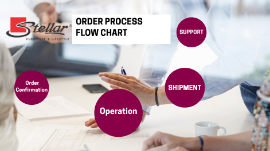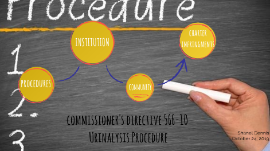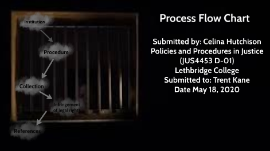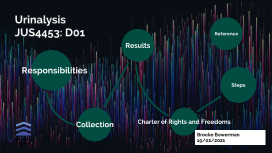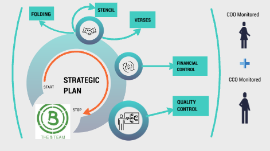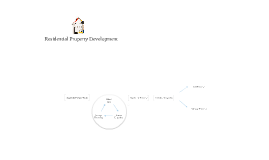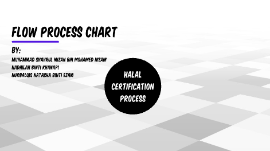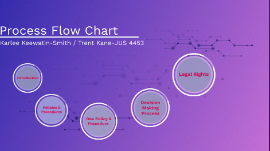Process Flow Chart
Transcript: Process Flow Chart Karlee Keewatin-Smith / Trent Kane-JUS 4453 Introduction Introduction My Directed Field Study is at the Medicine Hat Remand Centre (MHRC). This facility holds maximum, medium and minimum security offenders throughout four units. The correctional staff are responsible for the care, custody and control of individuals who have been arrested and are awaiting trial. Importance of Policies & Procedures Policies & Procedures A policy states what must be done, while a procedu... A policy states what must be done, while a procedure states how it must be performed. Policies and procedures need to be in place in order to guide the actions of the correctional officers, while also protecting the inmate's Charter of Rights and Freedoms. By having policies and procedures in place, they are used as a safeguard to protect correctional staff from accusations of misconduct, while also protecting the inmates from misconduct. Importance of Policies and Procedures One Policy & Procedure One policy For the purpose of this assignment, I have decided to analyze the policy: S. 10.10.01 Offender Searches. The policy on offender searches details: That searches must be conducted in a professional and respectful manner in order to ensure the safety and security of the MHRC Types of searches that are allowed and under what circumstances Who and how these searches can be conducted Who receives the search reports What happens if an inmate refuses to submit to a search A supervisor must ensure that the inmates are regularly searched and that correctional staff are trained on and reminded of the rules surrounding offender searches Decision Making Process Decision Making Process within the Offender Searches Policy and Procedure Policy states what events require a pat down and/or a strip search and/or a body orifice security scan. The decision-making process begins when contraband is retrieved from a routine search, when contraband is suspected and a non-routine search needs to occur; when medical emergencies arise and lastly, when an inmate refuses to be searched Routine search Routine search A routine search is when an inmate must be searched because they moved from one place to another; whether that is from one unit to another unit, or from another correctional facility, or from a law enforcement agency, etc A routine seach can also mean that the supervisor has scheduled a monthly strip search of the inmates If contraband surfaces during a routine search, the correctional officer must decide how to proceed. The correctional officer must decide whether the inmate should be dry-celled in case there is more contraband. The correctional officer must decide whether they should pursue internal or external charges. Lastly, the officer must decide whether dry-cell must occur upon every admission to jail after that if they are worried that this inmate poses a safety and security threat to Corrections Canada. Non-Routine Searches Non-Routine Searches A non-routine search is when a correctional officer is acting on reasonable grounds and/or suspicion of contraband being on or in an inmate. Non-routine searches can be targeted as the correctional officer may witness the inmate having the cigarette in their hand or based on recent history, an inmate may be searched first for the process of elimination. Another example of a non-routine search is one that is a random search as the correctional officer can smell someone smoking marijuana on the unit but cannot pinpoint the smell to one cell and/or one person, so they have the authority to search each person until the source is located. Non-Routine Searches Non-Routine Searches Decision 1: Once contraband is detected and/or suspected, the first decision is what to do next. The unit officer must pinpoint where the smell is coming from in order to begin searching for the source. The unit officer must decide whether they need the float to watch the unit while the unit officer inspects the unit and/or the inmates. They must decide whether the on-shift manager and/or the CPO III needs to be notified yet. Decision 2: Once the preliminary questions are answered, the next decision that needs to be made is 'do I have enough evidence to perform a non-routine search?' Decision 3: Once the unit officer believes that they have enough evidence to perform a non-routine search, they then must decide what search is best suited for the situation at hand. If an inmate is almost finished smoking a cigarette, a correctional officer would begin with a pat down to find the lighter or matches, and to see if any more cigarettes are in their possession. If the pat down proves unsuccesful, then a strip search would be conducted Non-Routine Searches Non-Routine Searches Decision 4: If the inmate is searched and contraband has been found, the correctional officer must make a decision about how to proceed. The correctional officer must decide whether the inmate only receives a shift lock up or whether unit discipline is






